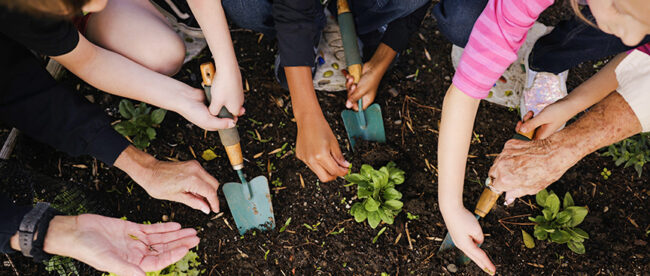Do’s and Don’ts of Lawn Makeovers
A look at our changemaking client, Santa Clarita Valley Water Agency
by Debbie Arrington
Landscape experts Chris Horton and Kurt Jurado have decades of experience transitioning turf into water-wise alternatives.
A landscape architect, Horton is a senior associate with Pacific Coast Land Design and has worked on major makeovers at local parks and landmarks, including the Santa Clarita sports complex. Owner of AIM Landscape & Irrigation, Inc., Jurado has designed hundreds of Santa Clarita area residential landscapes—including scores of drought-tolerant transformations.
“Water-wise landscapes have had some momentum with the help of the water agency rebates,” Jurado says. “SCV Water has also done a great job connecting homeowners with landscape designers. If the designer can create a landscape that complements the home and the homeowner’s style, it is a win-win.”
They know what works—and what doesn’t.
“Looking forward, most turf is a thing of the past,” says Horton. “It’s harder and harder to justify keeping turf,” especially when there are so many benefits to making the switch.
“The biggest benefit to water-wise landscapes is sustainability,” Jurado says.
In fact, experts agree that Southern California cannot endure large ornamental grass areas as the climate changes and droughts become more frequent and severe.
“All flora is essential,” Jurado says. “We simply need to incorporate those plants that do well in Santa Clarita, the plants that will survive the extreme heat and freezing temperatures but also reduce water usage.
“A second benefit is the lower maintenance cost,” he adds. “Most drought-tolerant landscapes can be maintained with a limited amount of time, reducing the cost of gardening services.”
Makeover don’ts
- Don’t plant turf, says Horton. Unless you need play space for pets and kids, plant something that uses less water.
- Don’t replace grass with artificial or synthetic turf. Says Horton, “This product gets really hot and may increase your bills for cooling your home.”
- Don’t overwater. “[It’s] the most common mistake homeowners make when transitioning to drought-tolerant landscapes,” says Jurado. “Most people are accustomed to watering plants when they start to wilt; drought-tolerant plants will not survive over-watering. Proper irrigation design and scheduling is very important.”
- Don’t stop watering trees. The lawn may be gone, but keep irrigating trees, your landscape’s most valuable asset.
Makeover do’s
- Create a design before you start digging. “Take photos, use Pinterest, provide direction for a designer,” says Jurado. “It is important that the homeowner is clear about what they don’t like.”
- Determine what areas will be “hardscaped,” covered with something other than plants and mulch. Hardscape includes permeable paths, decomposed granite, boulders, gravel, etc.
- Understand your soil conditions. Perform a soil test and amend soil as needed.
- Install plants that are proven for this area, says Jurado. “Don’t get plant risky. Add unique plants over time, but have a good plant base.”
- Plant the right trees. “The best thing you can do: Plant trees that will grow in your location,” Horton says. “Trees are really central to human survival in hot climates—they give us shade and oxygen. They provide excellent habitat to birds and bees. They’re critical to everything we need.” His suggestions: oaks, western redbud, strawberry tree, desert willow and mesquite.
- Plant pollinator-friendly plants, preferably native or adapted to our climate. Wildlife needs flowers with nectar and pollen, says Horton. Native wildlife prefers native plants. Examples: California lilacs, California poppies, yarrow, milkweed, California fuchsia and “every sage or salvia.”
- Use foundation plants to create a buffer with your neighbors. Suggestions include: coyote bush, coffeeberry, currants and toyon.
- Use shredded bark or other organic mulch, not rock and gravel mulch. Organics help build light fluffy soil; rocks absorb heat and cook roots.
Read the full publication here.
Related: Why drought-tolerant landscape is important—and is surprisingly easy to do yourself!


